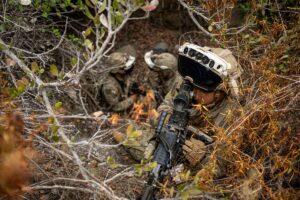The Army will “move on” from Microsoft [MSFT] if the company’s work developing the new “1.2” upgraded version of the Integrated Visual Augmentation System (IVAS) headset is unsuccessful, the service’s secretary said Tuesday.
“We want to see if we can get it to a place where it is going to be desirable for our soldiers. We think it can be. But I think Microsoft knows that this is it. They either get it done and get it to a place where our soldiers want to use it or we will move on,” Army Secretary Christine Wormuth told the Senate Appropriations Defense Subcommittee.

The Army’s FY ‘24 budget request included $165 million for IVAS, covering $76 million for further development of the new “1.2” version of the headset and $89 million to procure the upgraded system (Defense Daily, March 14).
“If Congress gives us the money that we requested for IVAS in this year’s budget, we are going to use that to work with Microsoft to get the system to a place where our soldiers will want to use it. And if Microsoft isn’t able to do that, we will not develop the program further,” Wormuth told the panel.
Wormuth’s remarks echo recent comments from Doug Bush, the Army’s top acquisition official, that the Army is prepared to hold a new competition for IVAS if testing with the 1.2 version of the headset is unsuccessful (Defense Daily, April 18).
“Institutionally for the Army, that’s always a hard decision to admit we can’t succeed somewhere. But this is a potential area where, look, if the testing doesn’t prove out very quickly that it’s capable and going to get us what we need, the Army is absolutely prepared to end that arrangement and seek a new competition,” Doug Bush said during a Senate Armed Services Airland Subcommittee hearing last month.
In March 2021, the Army awarded Microsoft a deal worth up to $21.9 billion over the next 10 years to move the IVAS augmented reality headset program from rapid prototyping into production (Defense Daily, March 31 2021).
“We are not going to spend $22 billion on a system if it doesn’t work,” Wormuth said Tuesday, noting the ceiling value of the contract “assumes fully fielding” the system into the future.
Following an operational test with the initial 1.0 version of IVAS last June, Army officials detailed a plan to adjust the program’s timeline to address reliability, low-light sensor performance and form factor issues identified during the evaluation.
In early January, the Army awarded Microsoft a $125 million deal to work on developing IVAS 1.2, which it said would include a new form factor and software improvements, with a goal to begin testing the upgraded system this fall (Defense Daily, Jan. 9).
Production of the new IVAS 1.2 is expected to begin in late FY ‘24 if testing is successful, the Army has said, with an aim for fielding to operational units by late FY ‘25.
Sen. Jeanne Shaheen (D-N.H.) pressed Wormuth on the Army’s lack of funding in its FY ‘24 budget request for the Enhanced Night Vision Goggles-Binocular (ENVG-B), built by L3Harris Technologies [LHX] and Elbit Systems of America [ESLT] while including more for IVAS.
“[ENVG-B] is a very good system. Our soldiers like it and they’re very comfortable with it. I think, one, we have a finite amount of resources that we can apply to modernization, so we are having to make choices,” Wormuth said in response. “What we’re trying to do with ENVG-B and IVAS is strike a balance. IVAS, as I know you know, does more than what the [night vision] goggles do. It is a system that allows our soldiers to train, rehearse and then fight in a synthetic training environment.”
L3Harris, which produces the system in Shaheen’s home state, and Elbit Systems of America each received production deals from the Army in October 2020 worth potentially $442 million to deliver ENVG-B devices to begin replacing its legacy monocular night vision devices (Defense Daily, Oct. 22 2020).
“I understand that aspiration but [IVAS] is not working yet. And until it works, it seems to me that we are shortchanging those people who need the current system that does work in a way that is not acceptable,” Shaheen said.
After the Army included no funding for ENVG-B in last year’s budget request but included the program on its unfunded priorities list, Congress appropriated $300 million for procurement of the night vision devices in the final version of the FY ‘23 budget (Defense Daily, Dec. 21).